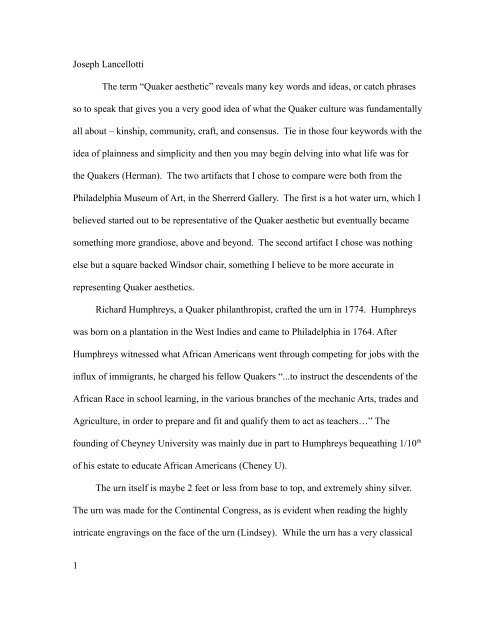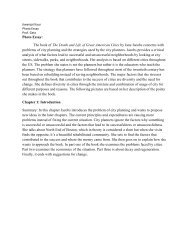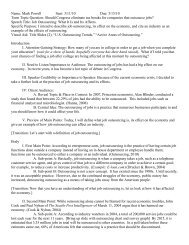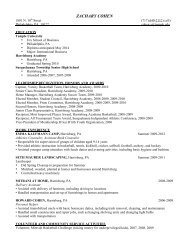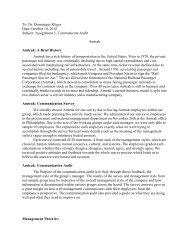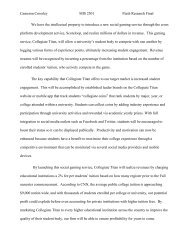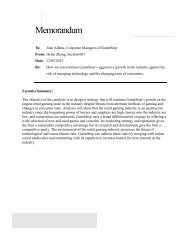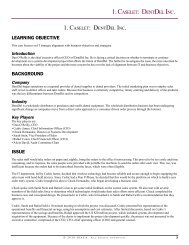Joseph Lancellotti The term âQuaker aesthetic ... - Temple Fox MIS
Joseph Lancellotti The term âQuaker aesthetic ... - Temple Fox MIS
Joseph Lancellotti The term âQuaker aesthetic ... - Temple Fox MIS
Create successful ePaper yourself
Turn your PDF publications into a flip-book with our unique Google optimized e-Paper software.
<strong>Joseph</strong> <strong>Lancellotti</strong><br />
<strong>The</strong> <strong>term</strong> “Quaker <strong>aesthetic</strong>” reveals many key words and ideas, or catch phrases<br />
so to speak that gives you a very good idea of what the Quaker culture was fundamentally<br />
all about – kinship, community, craft, and consensus. Tie in those four keywords with the<br />
idea of plainness and simplicity and then you may begin delving into what life was for<br />
the Quakers (Herman). <strong>The</strong> two artifacts that I chose to compare were both from the<br />
Philadelphia Museum of Art, in the Sherrerd Gallery. <strong>The</strong> first is a hot water urn, which I<br />
believed started out to be representative of the Quaker <strong>aesthetic</strong> but eventually became<br />
something more grandiose, above and beyond. <strong>The</strong> second artifact I chose was nothing<br />
else but a square backed Windsor chair, something I believe to be more accurate in<br />
representing Quaker <strong>aesthetic</strong>s.<br />
Richard Humphreys, a Quaker philanthropist, crafted the urn in 1774. Humphreys<br />
was born on a plantation in the West Indies and came to Philadelphia in 1764. After<br />
Humphreys witnessed what African Americans went through competing for jobs with the<br />
influx of immigrants, he charged his fellow Quakers “...to instruct the descendents of the<br />
African Race in school learning, in the various branches of the mechanic Arts, trades and<br />
Agriculture, in order to prepare and fit and qualify them to act as teachers…” <strong>The</strong><br />
founding of Cheyney University was mainly due in part to Humphreys bequeathing 1/10 th<br />
of his estate to educate African Americans (Cheney U).<br />
<strong>The</strong> urn itself is maybe 2 feet or less from base to top, and extremely shiny silver.<br />
<strong>The</strong> urn was made for the Continental Congress, as is evident when reading the highly<br />
intricate engravings on the face of the urn (Lindsey). While the urn has a very classical<br />
1
<strong>Joseph</strong> <strong>Lancellotti</strong><br />
shape to it, reminiscent of Quaker <strong>aesthetic</strong>, it reaches far passed any Quaker ideals.<br />
Humphreys experimented with the rising neoclassical style, which would show up<br />
heavily later during the Federal period (Lindsey). Any Quaker would not have this urn in<br />
their home, the urn just screams out elitist. While Quakers did enjoy distinctiveness, this<br />
urn is one of a kind, too distinct, and far from plainness and simplicity. <strong>The</strong> one question<br />
that I asked myself when I saw the urn is simply this – would a Quaker use this on a dayto-day<br />
basis? I would definitely say no to that. <strong>The</strong> urn does not represent necessity of<br />
living and day-to-day use that this urn would surely not see.<br />
Switching gears, the Windsor chair was made in the early 1800’s in Philadelphia,<br />
also found in the Sherrerd gallery. <strong>The</strong> chair features a square back; perfect simple<br />
symmetry and a very rustic color of aged brown. As soon as I saw the chair, I saw<br />
Quakers, meaning I envisioned that chair inside of a Quaker home, and everyday after the<br />
Quaker homeowner came back from work he would take a seat right in that chair. I<br />
believe the chair embodies the ideals of plainness and simplicity on a more realistic level<br />
than does the urn. However plain and simple the chair is, it also tells a tale of superior<br />
craftsmanship and even kinship – I can’t imagine anybody looking at that chair and not<br />
feeling some sort of attachment to it. That’s what I feel is the most important aspect of<br />
the chair – it’s homey feeling that I get from looking at it. <strong>The</strong> chair was clearly made for<br />
everyday life, but in no way does that diminish its extraordinarily simple but strong<br />
appearance.<br />
On the one hand you have the super stylish, in your face silver urn, which looks so<br />
2
<strong>Joseph</strong> <strong>Lancellotti</strong><br />
fancy it just begs never to be touched – heaven forbid you leave a fingerprint on it; then<br />
you have the chair – plain, simple, durable, yet so accessible at the same time. <strong>The</strong><br />
fundamental difference in the urn and the chair is you want to sit down in the chair, but<br />
you would hesitate and event thinking of touching the urn. In this way, I believe the<br />
Windsor chair embodies the work and ideals of Quakers while the urn simply works<br />
against them.<br />
Works cited<br />
Cheney U. Penn Powerpoint Presentation - https://docs.google.com/a/temple.edu/viewer?<br />
a=v&q=cache:VZNrxe0Rz9sJ:www.cheyney.edu/about-cheyneyuniversity/documents/RichardHumphreys_QuakerPhilanthropist.pdf+&hl=en&gl=us&pi<br />
d=bl&srcid=ADGEEShrl6YokQKpMuXu-<br />
HWYRuY69g1M5Gx0oT_KRBGOJMM5dC6TEMf6MGY3OIzK2f91uuY4PNm1m0t0PY5O1dIvWnlLX09kntZoIBQvyX7WPK3WT8HERhaJ1QGjhPnJ23vj4Fh66n&sig=AHIEtbTMi4<br />
bxQRKm7A0TnaDeyPQBD0qjZg&pli=1<br />
Herman, Bernard L, "Quakers as Producers," in Quaker Aesthetics.<br />
Lindsey, Jack L, from Philadelphia Museum of Art: Handbook of the Collections (1995),<br />
p. 262.<br />
3


